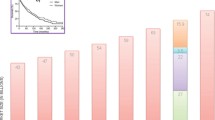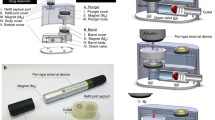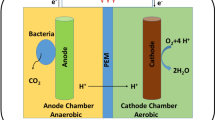Abstract
All presently used batteries contain reactive, corrosive or toxic components and require strong cases, usually made of steel. As a battery is miniaturized, the required case dominates its size. Hence, the smallest manufactured batteries are about 50 mm3 in size, much larger then the integrated circuits or sensors of functional analytical packages, as exemplified by implantable glucose sensors for diabetes management. The status of the miniaturization of the power sources of such implantable packages is reviewed. Three microcells, consisting only of potentially harmless subcutaneously implantable anodes and cathodes, are considered. Because their electrolyte would be the subcutaneous interstitial fluid, the cells do not have a case. One potentially implantable cell has a miniature Nafion-coated Zn anode and a biocompatible hydrogel-shielded Ag/AgCl cathode. The core innovation on which the cell is based is the growth of a hopeite-phase Zn2+ conducting solid electrolyte film on the discharging anode. The film blocks the transport of O2 to the Zn, preventing its corrosion, while allowing the necessary transport of Zn2+. The second cell, with the same anode, would have a bioinert hydrogel-shielded wired bilirubin oxidase-coated carbon cathode, on which O2 dissolved in the subcutaneous fluid would be electroreduced to water. In the third cell, the glucose of the subcutaneous interstitial would be electrooxidized to gluconolactone at an implanted wired glucose anode, similar to that tested now for continuous glucose monitoring in diabetic people, and O2 in the subcutaneous fluid would be electroreduced to water on its wired bilirubin oxidase cathode.



Similar content being viewed by others
References
Csöregi E, Schmidtke DW, Heller A (1995) Anal Chem 67:1240–1244
Heller A (1999) Annu Rev Biomed Eng 1:153–175
Wagner JG, Schmidtke DW, Quinn CP, Fleming TF, Bernacky B, Heller A (1998) Proc Natl Acad Sci USA 95:6379–6382
Feldman B, Brazg R, Schwartz S, Weinstein R (2003) Diabetes Technol Ther 5:769–779
Boto KG, Williams LFG (1977) J Electroanal Chem 77:1–20
Kordesch K (1962) US Patent 3,042,732, issued on July 3, 1962
Shin W, Lee J, Kim Y, Steinfink H, Heller A (2005) J Am Chem Soc 127:14590–14591
Whitaker A (1975) Acta Crystallogr B31:2026–2035
Whitaker A (1978) Acta Crystallogr B34:2385–2386
Feldman B, Liu Z, Mao F, Heller A (2005) US Patent Application 20050173245, published on August 11, 2005
Mano N, Kim H-H, Zhang Y, Heller A (2002) J Am Chem Soc 124:6480–6486
Hubbell JA, Kornfield JA, Tae G (2005) US Patent Application 2000559984, published on April 26, 2000
Mano N, Mao F, Heller A (2002) J Am Chem Soc 124:12962–12963
Mao F, Mano N, Heller A (2003) J Am Chem Soc 125:4951–4957
Mano N, Mao F, Heller A (2004) ChemBioChem 5:1703–1705
Mano N, Mao F, Heller A (2005) J Electroanal Chem 574:347–357
Mano N, Mao F, Heller A (2003) J Am Chem Soc 125:6588–6594
Kang C, Shin H, Zhang Y-C, Heller A (2004) Bioelectrochemistry 65:83–88
Kang C, Shin H, Heller A (2006) Bioelectrochemistry 68:22–26
Chen T, Barton SC, Binyamin G, Gao Z, Zhang Y, Kim H-H, Heller A (2001) J Am Chem Soc 123:8630–8631
Mano N, Fernandez Jose L, Kim Y, Shin W, Bard Allen J, Heller A (2003) J Am Chem Soc 125:15290–15291
Fernandez JL, Mano N, Heller A, Bard AJ (2004) Angew Chem Int Edit 43:6355–6357
Binyamin G, Chen T, Heller A (2001) J Electroanal Chem 500:604–611
Mano N, Mao F, Heller A (2004) Chem Commun 2116–2117
Mano N, Kim H-H, Heller A (2002) J Phys Chem B 106:8842–8848
Heller A (2004) Phys Chem Chem Phys 6:209–216
Heller A (2005) AIChE J 51:1054–1066
Acknowledgements
The writing of this review was supported in part by the Welch Foundation and the U.S. Office of Naval Research.
Author information
Authors and Affiliations
Corresponding author
Additional information
Part of the material reviewed was included in the authors lecture on the occasion of his receipt of the Fransenius Gold Medal and Prize of the Gesellschaft Deutscher Chemiker at ANAKON in Regensburg, Germany, on February 17, 2005.
Rights and permissions
About this article
Cite this article
Heller, A. Potentially implantable miniature batteries. Anal Bioanal Chem 385, 469–473 (2006). https://doi.org/10.1007/s00216-006-0326-4
Received:
Revised:
Accepted:
Published:
Issue Date:
DOI: https://doi.org/10.1007/s00216-006-0326-4




